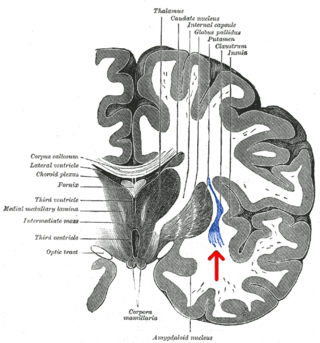Methods of neural tissue cooling
There are a few options for cooling neural tissue; the chosen method depends on the experimental design including the section of the brain being cooled (the section of interest) and the volume of that section.
Cryoloops
Cryoloops are cooling devices that use 23 gauge stainless steel hypodermic tubing shaped into a loop that can fit into sulci or on the gyri of the section of interest of the cerebral cortex. A pump draws methanol from a reservoir, and the fluid flows through a dry ice bath to be cooled. The cooled methanol flows through Teflon tubing into the cryoloop’s metal tubing, which is secured by passing through a threaded post. A thermocouple connector receives the wires from a microthermocouple at the base of the loop (where the inflow and outflow tubes meet) that measures the tubing temperature. The post, the thermocouple connector, and heat-shrink Teflon tubing, which envelopes the microthermocouple wires and the inflow and outflow tubes between the post and microthermocouple, are sealed using dental acrylic.

After implantation, when the animal is not participating in an experiment, a protective cap is placed over the open inflow and outflow tubes. During experimentation, the inflow and outflow tubes are attached to the Teflon tubing connected to the reservoir setup. The thermocouple connector is connected to a switchbox and a thermometer so cryoloop temperature can be monitored. [1] [2]
Cryoloops are considered the most adaptable form of cooling available due to the customization necessary for each experiment. The investigator must form the functional cooling loop of the cryoloop to fit with whatever part of the brain he/she wishes to study, and several cryoloops can be used for one brain. Each device can cool a range of tissue areas from less than 10 mm3 to 75 mm3. Although it may be considered a hassle to have to form each device for each section of interest, this customization allows for a more controlled region of cooling and for more efficient animal use because of the possibility for multiple cooling sites within each animal. Head restraint is unnecessary because the loops are chronically implanted and secured to the skull by screws and dental acrylic. [1] [2]
Cooling plates
Cooling plates are flat devices that are generally circular in shape and can cool tissue volumes of 35mm3 to 100mm3, usually by using thermoelectric cooling. [1] Some investigators may use a similar setup to one necessary for the cryoloop to cool the plate (flow of coolant through a dry ice bath). [3] However, the electrical connections required for cooling are a simpler method than the setup necessary for tubes filled with coolant. To ensure the stability of the plate upon implantation, the animal must undergo fixed-head restraint, which limits the type of behavior that can be studied. Also, plates cannot conform to some areas of the cerebrum due to the disparate shapes of the plate and the brain, and they have not been successfully introduced into sulci. [1]
Cryotips
Cryotips are made of two stainless steel hypodermic-needle tubes, such as 18 gauge tube surrounding a 24 gauge tube, soldered together. Like the cryoloop, cooled methanol flows through the inner tube to cool the device. If the investigator chooses to insulate the shaft of the tube, a low-resistance heater-wire can be wrapped around the outer tube except for 2 mm at the tip; passing a direct current through the wire keeps the shaft at normal brain temperature. This ensures localized cooling at the tip, which is inserted into the brain to reach deeper structures, without cooling the overlying structures. More than one microthermocouple is required to measure shaft and tip temperatures. [4] Modified versions of this device use smaller gauge tubing (21 and 30 gauge), and additional tubing is attached to form a y-shaped fork with HFC-134a cooling agent flowing through the double tubing while the fork is under vacuum. The vacuum causes the coolant to flow from the inner tubing into the outer tubing (so the coolant is in between the inner and outer tubes as well as inside the inner tube). [5] Cryotips are usually used to cool deeper structures of the brain that cannot be thermodynamically cooled from the surface. They are not used much in cortical cooling due to the small volumes that are cooled – investigators cooling cortical tissue are usually interested in larger sections than this device can cool. Cryotips cool tissue volumes of 2 mm3 to 5 mm3. [1] Usually the shaft of the device is insulated or even heated for localized cooling, however, some studies have used uninsulated cryotips to cool surface structures in addition to the deeper sections. [6]
Other
Epileptic patients can undergo surgical resection to reduce the occurrence of seizures, and cortical stimulation mapping identifies functional neural tissue to preserve it. However, up to 5% of these patients will suffer from an intraoperative seizures during mapping. Recently, cooled saline was used during surgical resection in some of these patients and was found to reduce intraoperative epileptiform discharges (electroencephalogram spike frequency decreased), suggesting the potential of intraoperative seizure can be decreased by cooling the tissue. [7]







